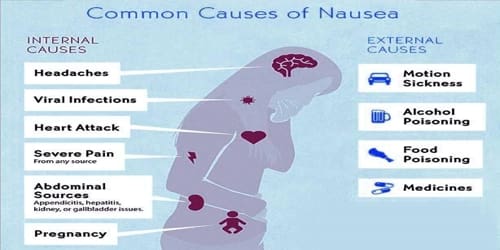Nausea
Definition: Nausea is a term that describes the feeling that people might vomit. While not painful, it can be a debilitating symptom if prolonged and has been described as placing discomfort on the chest, upper abdomen, or back of the throat. People with nausea have a queasy feeling that ranges from slightly uncomfortable to agonizing, often accompanied by clammy skin and a grumbling or lurching stomach.
Nausea almost always occurs before dry heaving or vomiting, although people can experience prolonged nausea without ever having to vomit. Nausea and vomiting can sometimes be symptoms of more serious diseases such as heart attacks, kidney or liver disorders, central nervous system disorders, brain tumours, and some forms of cancer.
Nausea is a non-specific symptom, which means that it has many possible causes. Some common causes of nausea are motion sickness, dizziness, migraine, fainting, low blood sugar, gastroenteritis (stomach infection) or food poisoning. Nausea is a side effect of many medications including chemotherapy, or morning sickness in early pregnancy. Nausea may also be caused by anxiety, disgust and depression.
Difference between nausea and vomiting: Nausea is an uneasiness of the stomach that often accompanies the urge to vomit, but doesn’t always lead to vomiting. Vomiting is the forcible voluntary or involuntary emptying (“throwing up”) of stomach contents through the mouth. Some triggers that may result in vomiting can come from the stomach and intestines (infection, injury, and food irritation), the inner ear (dizziness and motion sickness), and the brain (head injury, brain infections, tumours, and migraine headaches).
Medications taken to prevent and treat nausea are called antiemetics. The most commonly prescribed antiemetics in the US are promethazine, metoclopramide and the newer, extremely effective ondansetron. The word nausea is from Latin nausea, from Greek ναυσία – nausia, “ναυτία” – nautia, motion sickness, “feeling sick or queasy”.

Causes, Signs, and Symptoms of Nausea: There are many causes of chronic nausea. Nausea and vomiting remain undiagnosed in 10% of the cases. Aside from morning sickness, there are no gender differences in complaints of nausea.
The causes of nausea and vomiting are quite similar. Many things can bring on nausea. Some common causes are seasickness and other motion sicknesses, early pregnancy, intense pain, exposure to chemical toxins, emotional stress (fear), gallbladder disease, food poisoning, indigestion, various viruses, and certain smells or odours.
Some of the causes of nausea are:
- Alcohol, caffeine, excess sugar
- Anxiety, depression and eating disorders such as anorexia and bulimia nervosa
- Addison’s disease
- Appendicitis
- Brain tumor
- Hydrocephalus or “water on the brain”
- Cancer and chemotherapy
- Viral infections including chicken pox, influenza, stomach flu and norovirus
- Chronic fatigue syndrome
- Head injuries
- Diabetes and associated gastroparesis
- Crohn’s disease, ulcerative colitis, irritable bowel syndrome
- Gastroesophageal reflux disorder
- Gastroenteritis or food poisoning
- Pancreatitis
- Peptic ulcer
- Ear disorders, dizziness, Meniere’s disease, vertigo
- Certain medications
- Drugs of abuse
- Heart attack or acute myocardial infarction
- Electrolyte imbalance, mainly a rise in blood levels of potassium
- Raised pressure within the skull
- Meningitis or inflammation and infection of the membranes covering the brain
- Kidney failure and kidney disorders
- Migraine
- Morning sickness associated with pregnancy
- Premenstrual syndrome and menstruation
- Pneumonia
- Stress and sleep deprivation
- Withdrawal syndrome
- Liver disorders and hepatitis
Nausea is an unpleasant although usually painless symptom. The most common symptom that occurs with nausea is vomiting. Symptoms that are also associated with nausea include dizziness, faintness, dry mouth, diarrhea, fever, abdominal pain, and decreased urination.

Serous symptoms that may accompany nausea include chest pain, confusion, lethargy, rapid pulse, breathing difficulty, excessive sweating, and fainting.
Diagnosis and Treatment of Nausea: There are several ways to control or relieve nausea; however, if these techniques do not seem to ease the queasiness, consult the doctor. If the patient’s symptoms have an acute onset, then drugs, toxins, and infections are likely. In contrast, a long-standing history of nausea will point towards a chronic illness as the culprit.
Liver function tests and lipase would identify pancreaticobiliary diseases. Abdominal X-rays showing air-fluid levels indicate bowel obstruction, while an X-ray showing air-filled bowel loops are more indicative of ileus. More advanced imaging and procedures may be necessary, such as a CT scan, upper endoscopy, colonoscopy, barium enema, or MRI. Abnormal GI motility can be assessed using specific tests like gastric scintigraphy, wireless motility capsules, and small-intestinal manometry.
Treatment for nausea depends on the underlying cause. In most cases, nausea resolves by itself, especially if relieved by throwing up. Treatment may include plenty of fluids and a clear liquid diet. Severe nausea may require treatment with medications.
Ginger has also been shown to be potentially effective in treating several types of nausea. Most people recover within a few hours or a day. While short-term nausea and vomiting are generally harmless, they may sometimes indicate a more serious condition.

Prevention of Nausea: Most people recover within a few hours or a day. While short-term nausea and vomiting are generally harmless, they may sometimes indicate a more serious condition. Nausea can be prevented by:
- Eating small meals throughout the day instead of three large meals;
- Eating slowly;
- Avoiding hard-to-digest foods; and
- Consuming foods that are cold or at room temperature to avoid becoming nauseated from the smell of hot or warm foods.
Avoid riding in the backseat of cars of people are know they get motion sickness. If people feel a wave of nausea coming on, try to take deep, cleansing breaths and don’t think about vomiting, which can make nausea worse. Drink liquids between (instead of during) meals, and drink at least six to eight 8-ounce glasses of water a day to prevent dehydration. Try to eat when they feel less nauseated.
Information Source:
















